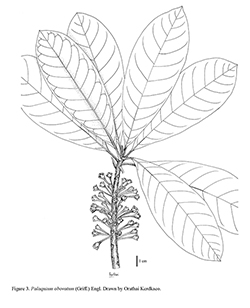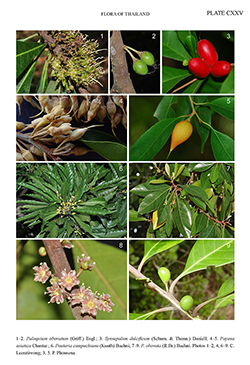e-Flora of Thailand
Volume 11 > Part 4 > Year 2014 > Page 636 > Sapotaceae > Palaquium
6. Palaquium obovatum (Griff.) Engl.wfo-0000262633
Bot. Jahrb. Syst. 12: 511. 1890; Brandis, Indian Trees: 425. 1906; Ridl., Fl. Malay Penins. 2: 273. 1923; H.J.Lam, Bull. Jard. Bot. Buitenzorg, Sér. 3, 7: 83, 257. 1925 & 3, 8: 408. 1927; Lecomte, Fl. Indo-Chine 3: 899, f. 99. 1930; H.R.Fletcher in Craib & Kerr, Fl. Siam. 2: 356. 1938; P.Royen, Blumea 10: 453. 1960; Aubrév., Fl. Cambodge, Laos & Vietnam, Sapotacées: 51, pl. 7, f. 1-5. 1963; Ng in Whitmore, Tree Fl. Malaya 1: 423, f. 9. 1972; Pennington, Gen. Sapot.: 151. 1991; Chantar., Thai Forest Bull., Bot. 27: 153. 1999; Abang Mohd. Mohtar in Soepadmo, Saw & Chung, Tree Fl. Sabah & Sarawak 4: 296. 2002.— Isonandra obovata [‘obovatis’] Griffith, Not. Pl. Asiat. 4: 293. 1854; Kurz, Forest Fl. Burma 2: 120. 1877.— Dichopsis obovata C.B.Clarke in Hook.f, Fl. Brit. India 3: 542. 1882. Fig. 3; Plate CXXV: 1–2.
Accepted Name : This is currently accepted.
Synonyms & Citations :
Description : Tree to 35 m tall; branchlets terete or angular, puberulous, glabrescent. Leaves scattered or mostly at apex of branchlets; lamina coriaceous, obovate, obovate-oblong or oblong, 13–29 by 5.5–14.7 cm; apex acute, obtusely acuminate or obtuse, rarely retuse; base narrowly to broadly cuneate, decurrent; upper surface glabrous or with sparse short appressed hairs, lower surface with sparse short appressed hairs; midrib grooved, minutely crested above, rounded below; secondary veins 7–14 on each side, vanishing near margin, looped in apical part of leaf; tertiary veins, transverse; petioles 1.5–3.5 cm long, grooved or flat in the apical half, rounded in the basal part, puberulous, glabrescent; stipules lanceolate or linear, 4–10 by 1.5 mm, puberulous outside, glabrous inside, caducous. Flowers 4–12 in axils of fallen leaves; pedicels angular, 1.6–2 cm long, reddish brown tomentose. Sepals 6, reddish brown tomemtose outside, glabrous inside; outer sepals triangular or broadly ovate, 2.7–4.5 by 2.8–4 mm; inner sepals orbicular or ovate, 3.5–4.1 by 3.5–4 mm, crested, with membranous, glabrous, fimbriate margin. Corolla 1.2–1.4 cm long, entirely glabrous; tube 5 mm long; lobes 6, lanceolate-oblong, 7.5–8.2 by 2.7–3.2 mm. Stamens 12, 6.5–7.5 mm long; filaments filiform, 5 mm long, glabrous; anthers sagittate, ovate or oblong-ovoid, extrorse, 3.5–4 mm long, reddish brown sericeous; connective acuminate, 0.2–0.3 mm long. Ovary conoid, 6-locular, 12-lobed, glabrous; style 2–2.8 cm long, exserted, glabrous. Fruits pruniform to globose or obpyriform, to 2.8 by 2.2 cm, 1–2-seeded. Seeds ellipsoid, ca 2.5 by 1.2 by 1 cm, laterally compressed.
Thailand : NORTHERN: Chiang Mai (Doi Suthep-Pui); SOUTH-EASTERN: Chanthaburi (Laem Sing, Khlung), Trat (Ko Chang, Khao Saming); PENINSULAR: Chumphon (Ko Tao, Siap Yuan, Tha Sae, Lang Suan), Ranong, Surat Thani (Ko Pah, Krabi, Satun (Tarutao, Adang island, Khuan Pho), Trang (Kan Tang, Khao Chong), Songkhla (Hat Yai, Khao Kaeo, Ko Ma), Narathiwat (Khok Mai Ruea, Khae Chana, Tak Bai).
Distribution : India, Myanmar, Indochina, Peninsular Malaysia (type), Borneo, Sumatra.
Ecology : In evergreen forests, 0–300 m alt.
Vernacular : Khanun nok (ขนุนนก), sang (ซาง), yang khanun nok (ยางขนุนนก)(Chanthaburi); tiao phru (เตียวพรุ)(Krabi); yak-teng (ยักเต็ง), yue-ra-to (ยือราโต๊ะ), ya-tu (ยาตู)(Malay-Pattani, Narathiwat).


